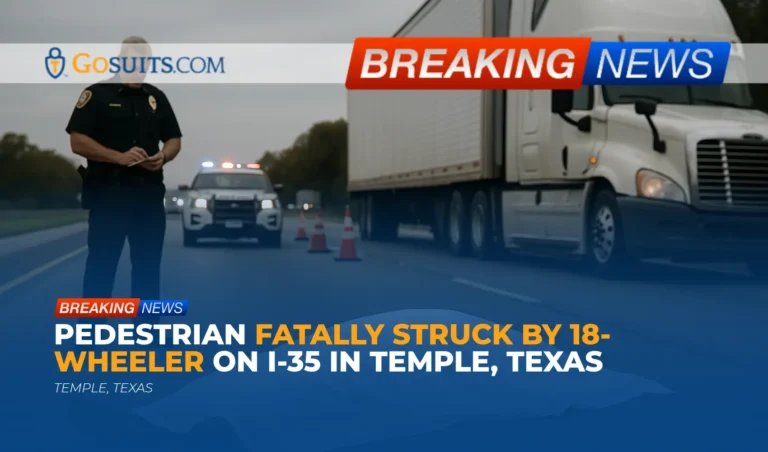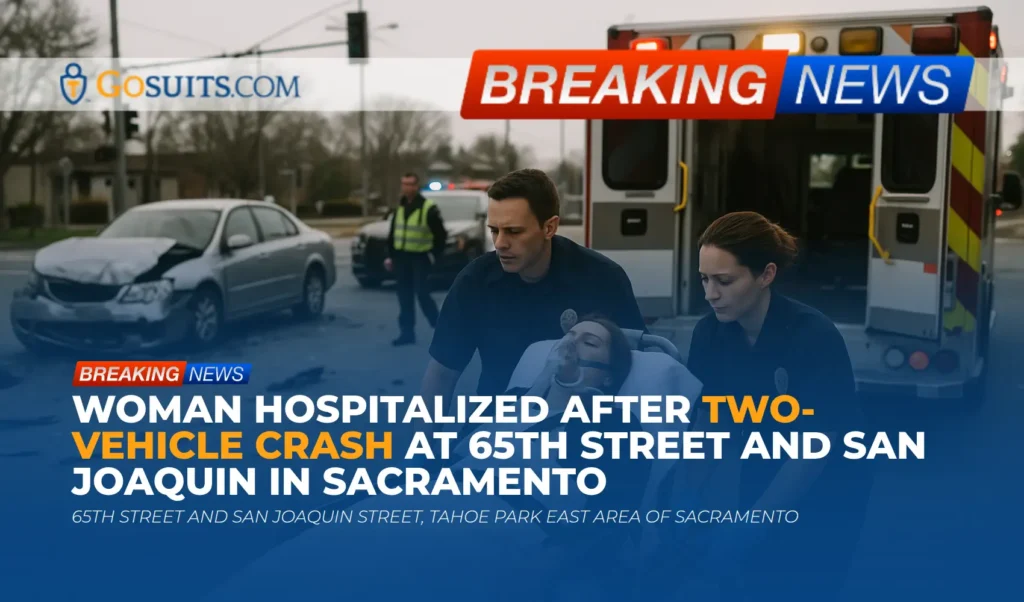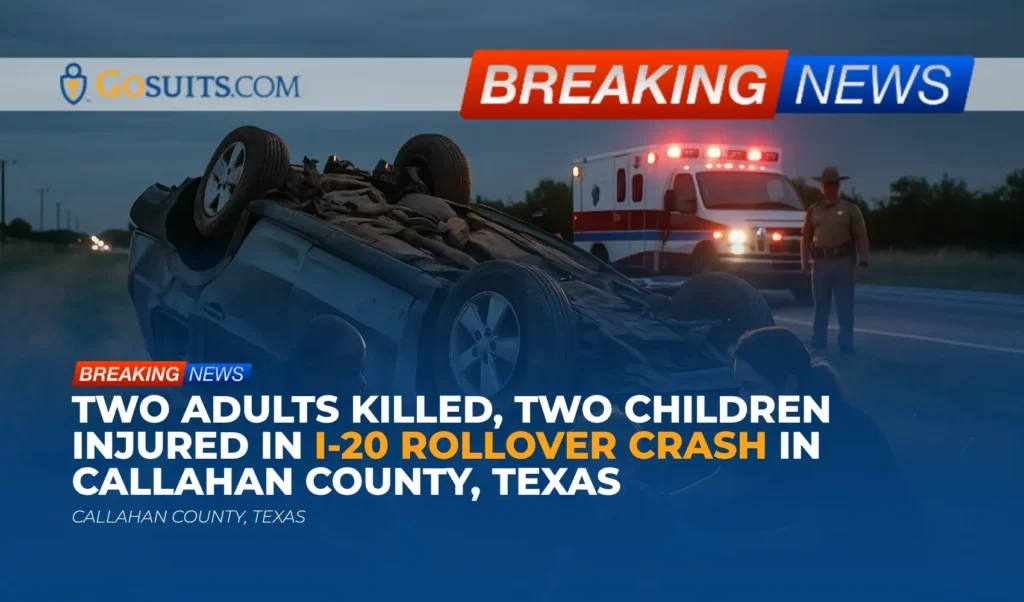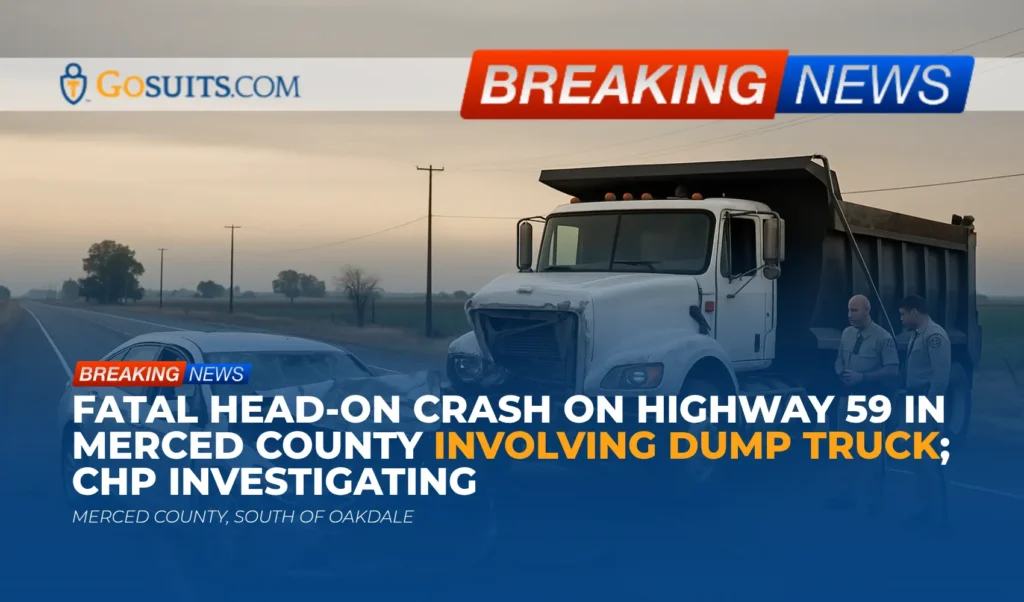- What is known about the I-35 pedestrian fatality in Temple
- Which agencies typically handle crashes like this and what they do
- How to obtain official records and documents
- Texas civil law context in a pedestrian and 18-wheeler crash
- Evidence that often matters in an 18-wheeler pedestrian case
- Insurance and compensation landscape
- Practical steps to consider in the days and weeks after a fatal crash
- Safety considerations for the community
- Reliable public information and supportive resources
- Why acting promptly matters after a fatal highway collision
- Commentary from Gosuits Temple, Texas Personal Injury Attorney
What is known about the I-35 pedestrian fatality in Temple
Reports indicate that a pedestrian was struck and killed by an 18-wheeler on Interstate 35 in Temple. Based on the limited information publicly available, the crash occurred on I-35 within Temple city limits. Details such as the time of day, precise mile marker, direction of travel, and circumstances have not been released in the initial report. The identity of the pedestrian is typically withheld by authorities until family notification is complete. In Texas, fatal highway incidents of this nature trigger an immediate response from local police and often state agencies to secure the scene, assist victims, divert traffic, and begin a crash investigation.
In any fatal collision, law enforcement agencies generally document the scene, collect statements, and preserve evidence for reconstruction. When a commercial motor vehicle is involved, additional factors are often reviewed, including the truck driver’s hours of service, vehicle inspection and maintenance status, and potential visibility or roadway conditions. At this early stage, it is important not to speculate. Facts usually become clearer as official reports and witness accounts are compiled.
Which agencies typically handle crashes like this and what they do
Although each case is unique, a fatal pedestrian collision on an interstate within Temple may involve the following public agencies:
- Temple Police Department (TPD) typically responds within city limits, manages the scene, and prepares an initial crash report. The City of Temple provides public information and department contacts on templetx.gov.
- Texas Department of Public Safety (DPS) often assists with or leads crash investigation on interstate highways. DPS oversees statewide crash records and the Crash Records Information System. Information about crash reports is available from DPS Crash Records.
- Texas Department of Transportation (TxDOT) maintains the interstate and may assist with traffic control and incident response. Members of the public can purchase the official Texas crash report (CR-3) through TxDOT’s portal at CRIS Purchase.
- County medical examiner or justice of the peace oversees the inquest and cause-of-death determination under Texas law. The inquest process is governed by the Texas Code of Criminal Procedure Chapter 49, available at Chapter 49.
These agencies have distinct roles: police and DPS document the crash; TxDOT maintains roadway operations and the state crash database; and the medical examiner or justice of the peace handles the inquest, potential autopsy, and next-of-kin notifications in accordance with state law.
How to obtain official records and documents
Police crash report from local authorities
The initial crash report prepared by local police can help families understand the basic facts, such as the responding officers, time and location, involved vehicles, and preliminary diagrams. The City of Temple maintains public-facing contact information at templetx.gov, where the Police Department and Records Division can guide requesters on how to obtain available reports under the Texas Public Information Act. Availability and timing can vary, especially in a fatality investigation.
Official Texas CR-3 crash report
In Texas, the official CR-3 crash report is filed for reportable crashes and can be purchased online once it is processed. TxDOT’s Crash Records Information System provides public access to purchase the report at cris.txdot.gov/public/Purchase. DPS provides additional guidance on crash records at dps.texas.gov/section/crash-records. These reports can include diagrams, contributing factors as assessed by the investigating officer, and information on road and weather conditions.
Autopsy, inquest, and death certificates
Where a death occurs suddenly or involves a motor vehicle collision, state law calls for an inquest by a justice of the peace or medical examiner, and in some circumstances an autopsy. The process is governed by the Texas Code of Criminal Procedure Chapter 49, accessible at Chapter 49.
Certified copies of death certificates are available through the Texas Department of State Health Services Vital Statistics Section, with information on eligibility and ordering at dshs.texas.gov/vital-statistics/death-records. For questions regarding an autopsy report or inquest findings, the appropriate county authority can advise on access rules and timing under the Texas Public Information Act.
Who to contact for questions
- Temple Police Department Records for local crash report access and case numbers. See templetx.gov for department contacts.
- Texas DPS Crash Records for statewide crash data guidance: dps.texas.gov/section/crash-records.
- TxDOT CRIS to purchase the official CR-3: cris.txdot.gov/public/Purchase.
- Texas DSHS Vital Statistics for death certificates and related records: dshs.texas.gov/vital-statistics/death-records.
Texas civil law context in a pedestrian and 18-wheeler crash
While each situation is different, fatal collisions involving pedestrians and commercial trucks often raise questions about duty of care, potential negligence, and the avenues available to surviving family members under Texas civil law. The points below provide general context.
Duty of care for drivers around pedestrians
Texas law requires drivers to exercise due care to avoid colliding with a pedestrian. This duty includes giving warning by sounding the horn when necessary and exercising proper precaution when a pedestrian is on the roadway. See Texas Transportation Code section on drivers’ duty to exercise due care at Transportation Code 552.008. Drivers must also operate at a speed that is reasonable and prudent under the circumstances, considering actual and potential hazards, as reflected in Transportation Code 545.351.
Pedestrian responsibilities also exist under Texas law, such as using available sidewalks and obeying traffic control signals, found in the Transportation Code Chapter 552 at Chapter 552. Importantly, even if a pedestrian may have been in a challenging or unsafe location, that does not remove a driver’s obligation to use due care. The precise legal implications depend on the totality of the facts.
Commercial truck rules that may be relevant
Commercial motor vehicles and their drivers are regulated by federal safety rules. Depending on the truck’s operations, the following may be relevant to a civil investigation:
- Hours of Service compliance to reduce fatigue, summarized by the Federal Motor Carrier Safety Administration at FMCSA Hours of Service.
- Vehicle inspection, repair, and maintenance rules at 49 CFR Part 396.
- Drug and alcohol testing requirements for commercial drivers at 49 CFR Part 382.
These regulations do not determine civil fault by themselves, but they can inform whether a trucking company and its driver met safety obligations.
Wrongful death and survival actions in Texas
Texas law provides civil causes of action that may apply when a person is killed due to the wrongful act, neglect, carelessness, unskillfulness, or default of another. The Wrongful Death statute is found in the Texas Civil Practice and Remedies Code Chapter 71, available at Chapter 71. A Survival action permits the deceased’s estate to pursue certain claims the deceased could have brought had they lived. See CPRC 71.021. Eligibility, recoverable damages, and procedural requirements depend on the facts and the statutes.
Statute of limitations and notice requirements
In many Texas civil injury and wrongful death cases, the general statute of limitations is two years from the date of the incident, as addressed in CPRC 16.003. There can be exceptions or shorter deadlines, especially where a governmental entity may be implicated by roadway design or maintenance. Certain claims against government entities require timely notice under the Texas Tort Claims Act. These timelines are important to understand early.
Potential parties and theories of civil liability
Possible civil responsibility in a fatal pedestrian and truck collision can involve more than one party. Depending on the evidence, investigations may consider:
- The truck driver for alleged negligent operation, such as speed too fast for conditions, failure to maintain a proper lookout, or distraction.
- The motor carrier or trucking company for negligent hiring, training, supervision, dispatch, hours-of-service compliance, or vehicle maintenance.
- Other motorists whose actions may have created hazards or chain reactions.
- Roadway or work zone management issues where signage, lighting, or barriers may become relevant. Claims implicating a government entity raise additional legal considerations under the Texas Tort Claims Act.
- Freight brokers or shippers in limited circumstances, depending on control and safety-related decisions.
Careful fact gathering is essential before reaching conclusions.
Claims involving government entities and roadway design
If a claim appears to involve a city, county, or state transportation agency regarding roadway conditions, traffic control devices, or work zone management, specialized rules and liability limitations may apply under the Texas Tort Claims Act. These matters include strict notice and proof requirements. Because public safety agencies also participate in investigating crashes, separating investigative roles from civil liability questions requires careful attention to the law and the facts.

Evidence that often matters in an 18-wheeler pedestrian case
Preserving evidence quickly can make a difference in understanding what occurred. Below are examples of materials that often prove important in cases involving commercial trucks and pedestrians. The list is general and may not apply in every situation.
- Electronic Logging Device (ELD) data showing hours of service and rest periods.
- Engine Control Module (ECM) and event data with speed, braking, throttle, and fault codes near the time of the collision.
- In-cab and exterior dash camera video from the truck, and any available traffic or nearby business cameras capturing the scene.
- Driver’s handheld or telematics records including dispatch communications and location pings.
- Driver qualification file and training records, including road test, medical certificate, and prior incidents, as required by federal rules for many carriers.
- Vehicle inspection, repair, and maintenance logs, including annual inspections and pre-trip and post-trip reports under 49 CFR Part 396.
- Bill of lading and load information to confirm route, schedule, and any pressures that may have affected driving behavior.
- Scene evidence such as tire marks, debris fields, vehicle lighting condition, road lighting, and weather data.
- Witness statements and 911 audio where available.
- Medical examiner or inquest findings that may clarify time and mechanism of death under Chapter 49.
Because some data can be overwritten in days or weeks, prompt written preservation requests are frequently used to help prevent loss of relevant materials.
Insurance and compensation landscape
Understanding the insurance framework can help families anticipate what information may become important. The discussion below is general and not case specific.
Commercial auto liability requirements
Motor carriers operating commercial motor vehicles in interstate commerce must maintain minimum levels of financial responsibility under federal law. The minimum for most general freight is set out in the federal rules, with details in 49 CFR Part 387. Different limits apply for hazardous materials and passenger carriers. The exact policies and endorsements, including any MCS-90 endorsement, can be significant in a civil claim.
Company policies, umbrella, and excess coverage
In addition to federally required minimums, trucking companies may carry higher limits, umbrella, or excess policies. Identifying all available coverage often requires careful review of policy documents, filings, and contractual relationships between carriers, owners, and shippers.
Workers’ compensation considerations
If the person on foot was present in a work capacity, potential workers’ compensation death benefits and burial benefits may be relevant. The Texas Department of Insurance provides public information about workers’ compensation benefits at tdi.texas.gov. This consideration depends entirely on employment status and on-the-job facts.
Why speaking to insurers without counsel can be risky
Insurance adjusters and company investigators often reach out quickly after a serious crash. Statements made early can be recorded and may be used later in ways that are not obvious at the time. Before speaking to any insurer about the facts or signing claims forms, it is prudent to contact a qualified attorney for a free consultation to understand rights and obligations. What is said to an insurance company can be used against a claimant later.
Practical steps to consider in the days and weeks after a fatal crash
Every family’s situation is different. The following general steps are commonly helpful after a fatal highway collision.
- Obtain the basic incident information such as the responding agency’s case number, officer contact, and tow or storage location, if applicable. The City of Temple’s website at templetx.gov lists police and public records contacts.
- Request or calendar the official Texas crash report through TxDOT’s CRIS portal at cris.txdot.gov/public/Purchase. These reports can take days to weeks to become available.
- Confirm the inquest and certificate process with the appropriate county authority and request certified death certificates through Texas DSHS Vital Statistics.
- Preserve potential evidence by noting any witnesses, photos, and locations of cameras that may have captured the event. Consider sending a timely written preservation notice to the motor carrier to prevent loss of electronic data.
- Be cautious with insurance communications. Before giving any recorded statement or signing authorizations, contact an attorney for a free consultation to understand how to proceed.
- Organize key documents such as medical and funeral records, employer letters, and any correspondence from insurers or government agencies.
- Consider support resources for grief and mental health as needed. A public overview of 988 crisis support is available at samhsa.gov/find-help/988.
Safety considerations for the community
Interstate corridors are unforgiving environments for anyone outside of a vehicle. Pedestrians can include stranded motorists, first responders, tow operators, road workers, and people facing emergencies. The following context may help community members understand risks and responsibilities without speculating about this particular incident.
Interstate pedestrian risk and driver duties
High speeds, limited stopping distances, and reduced reaction time make interstates hazardous for pedestrians. Texas Transportation Code Chapter 552 outlines pedestrian rules and driver responsibilities. Drivers have a legal duty to exercise due care to avoid collisions with pedestrians under Transportation Code 552.008. Even in challenging environments, attentive driving, appropriate speed for conditions, and proper lookout are critical safety measures.
Large truck stopping distance and visibility
Commercial tractor-trailers require longer distances to perceive, react, and stop compared to passenger vehicles. Nighttime conditions, glare, roadway geometry, and lighting can reduce visibility. NHTSA provides accessible road safety information on large trucks at nhtsa.gov/road-safety/large-trucks and pedestrian safety guidance at nhtsa.gov/road-safety/pedestrian-safety. While these resources do not determine fault, they help explain why the combination of a pedestrian and a large truck on a freeway is especially dangerous.
Recent safety trends
Nationally, pedestrian fatalities have drawn significant attention in recent years. NHTSA’s public materials reflect ongoing efforts to address pedestrian safety through driver awareness, roadway design, and enforcement. See NHTSA pedestrian safety for background and prevention strategies.

Reliable public information and supportive resources
- City of Temple public safety and records information: templetx.gov.
- Texas DPS Crash Records: guidance on crash reports and records requests at dps.texas.gov/section/crash-records.
- TxDOT CRIS Purchase: official Texas CR-3 crash report portal at cris.txdot.gov/public/Purchase.
- Texas DSHS Vital Statistics: death certificates and vital records at dshs.texas.gov/vital-statistics/death-records.
- FMCSA Regulations: federal safety rules for commercial motor vehicles, including Hours of Service and Inspection, Repair, and Maintenance.
- NHTSA Road Safety: large trucks and pedestrian safety resources at nhtsa.gov/road-safety/large-trucks and nhtsa.gov/road-safety/pedestrian-safety.
- Texas Transportation Code and Civil Practice and Remedies Code: official statutes at Transportation Code Chapter 552, Transportation Code 545.351, CPRC Chapter 71, and CPRC 16.003.
- SAMHSA 988 information for crisis and emotional support: samhsa.gov/find-help/988.
Why acting promptly matters after a fatal highway collision
Time can affect evidence, deadlines, and benefits connected to a fatal crash. Taking early, informed steps helps protect the ability to find answers and pursue available civil remedies. The following points explain why prompt action often matters.
- Key evidence can be lost quickly. Electronic logging data, in-cab videos, and vehicle telematics may be overwritten in days or weeks during normal fleet operations. Early preservation requests help prevent loss.
- Government notice rules may apply. If roadway conditions, traffic control, or work zones are potentially involved, notice deadlines under state law can be shorter than the general statute of limitations. Missing a notice deadline can limit options.
- Insurance investigations start immediately. Motor carriers and their insurers often investigate within hours. Without a clear plan, important context or witnesses might be overlooked or mischaracterized.
- Medical and funeral documentation builds the record. Timely collection of certified death certificates, funeral invoices, and related documents supports later claims and benefits processes.
- Financial responsibilities continue. Understanding available benefits, potential wage-related claims, and insurance coverage can inform decisions about short-term needs and long-term planning.
- Consultation provides clarity. A free legal consultation before interacting with insurers can help clarify rights and next steps. Statements given to an insurance company can be used later and should be made with full awareness of the implications.
Acting with intention does not mean rushing. It means prioritizing preservation of rights, evidence, and access to accurate information during a difficult time.
Commentary from Gosuits Temple, Texas Personal Injury Attorney
We are deeply sorry to hear of a life lost on I-35 in Temple. Crashes involving pedestrians and 18-wheelers are devastating for families and communities. This commentary is offered for educational purposes and general information, and it is not a substitute for advice about any specific situation.
From a civil injury perspective, a careful, methodical investigation is essential. The law requires all drivers to use due care to avoid colliding with pedestrians, and commercial carriers have additional safety responsibilities. In practice, that means examining the truck’s electronic data, maintenance and inspection records, hours-of-service compliance, lighting and visibility, speed for conditions, and the roadway environment at the time of the collision. It also means reviewing witness information and any available video. Only by assembling these pieces can one fairly assess how and why a fatal crash occurred.
Insurance companies and corporate defendants typically move quickly to protect their interests. Adjusters and investigators may contact people close to the event, ask for recorded statements, or request broad authorizations. This can be overwhelming. It is important to remember that what is said to an insurer can be used later. Companies understand the rules and timelines very well, and they may rely on that unequal knowledge. Seasoned counsel can help level the playing field by requesting preservation of critical evidence, organizing the factual record, and guiding communications.
A no-cost consultation is an opportunity to understand options and timelines without pressure. It helps clarify how Texas statutes, insurance policies, and federal safety rules may apply, and what steps can protect the ability to seek accountability. Even a short conversation before engaging with insurers can prevent missteps and provide much-needed clarity during a difficult time.






